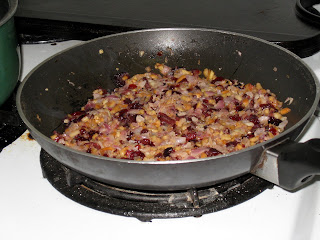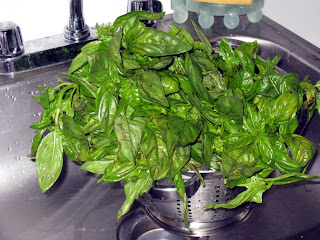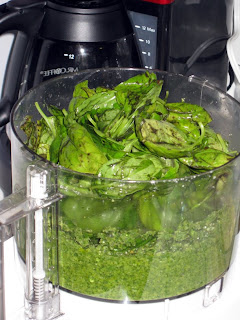""Proust had his madeleines; I am devastated by the scent of yeast bread rising."" ~ Bert Greene
Saturday, September 27, 2008
Monday, September 15, 2008
Peppers and Sausage
Saturday, September 13, 2008
Pesto 101
Friday, September 12, 2008
Plan B
| I am a creature of happy accidents. Fate has never had any interest in my plans, big or small, but has always imposed a somewhat more adventurous scheme. This past weekend was no exception. | |
| I had intentions of photographing (and buying) late summer's bounty at the Union Square Farmer's Market and posting beautiful shots of heirloom tomatoes, red onions, artisan breads, purple basil and autumn greens. The blog was gonna write itself. Hell, all I had to do was hold the camera steady. A no-brainer, one would think. Trouble was, it was Sunday and there was no market that day. That small fact somehow never penetrated my euphoria as I was planning my strategy. Call me distracted, but after Saturday's deluge I was just grateful for some sunshine. | |
| But back to happy accidents. What could have been a disappointing morning was saved by my buddy, let's call him El Diablo, and his fur trapper's knowledge of Manhattan. After meeting me at Grand Central and hopping a subway to Union Square where our date with destiny awaited, El Diablo promised Technicolor tomatoes and more just a few blocks away. In the process he turned a simple blog entry into an informed and totally awesome walking tour of the east Village. | |
 We walked south on Broadway and then east on 11th in the direction of Thompson Square Park. At 11th and 2nd Avenue, E.D. claimed that we just had to stop for a snack: Plump Dumpling. This place is no wider than the hallway in my apartment building. When you enter, you're practically on top of the cook and his wok. There's literally just enough space to stand and order, then you better move out of the way for the next guy. We walked south on Broadway and then east on 11th in the direction of Thompson Square Park. At 11th and 2nd Avenue, E.D. claimed that we just had to stop for a snack: Plump Dumpling. This place is no wider than the hallway in my apartment building. When you enter, you're practically on top of the cook and his wok. There's literally just enough space to stand and order, then you better move out of the way for the next guy.Plump Dumpling is a favorite with NYU students and the hippies - young & old - who call the east Village home. Plump Dumpling does offer a full menu, but you go there for their little doughy pockets of goodness: fried or steamed, in a broth or standing alone. You can choose from meat, vegetable, chicken, seafood, or shrimp. The intriguing choice of "meat" was a tease. Beef? Pork? Something, shall we say, more exotic? I was just getting up my nerve when I noticed that "meat" was cheaper than both chicken and vegetable. In this instance I decided bargain hunting would be imprudent. | |
| We settled on pan-fried chicken dumplings. They came 8 to an order for $4.25; a real bargain. We stood on the sidewalk just outside the entryway dipping our dumplings in sauce trying to outdo one another with hyperbole. They were superior dumplings. | |
| We completed the last few blocks to Thompson Square and meandered through the park before confronting the stalls along Avenue A. We stopped to watch the dogs and owners in the dog run, a generous space with pools and deep, coarse sand for the pooches, and lots of benches for the bi-peds. Thompson Square Park is famous for a riot that went on there in 1988 when local officials tried to remove the vagrants who congregated in the park and squatted in the surrounding vacant buildings. Police officers were particularly zealous that day, brutally beating protesters, bystanders and even reporters. Lots of archived footage of the protest can be found on the web. Here's an excerpt from gothamist on a punk rock concert commemorating the protest last month. | |
| |
| Today, drunks, young professionals, skaters and tree huggers share the park and mostly get along fine. | |
  | |
| There were plenty of stalls with beautiful, open-pollinated tomatoes, a dozen types of peppers from green to chocolate, chilies of every size and heat, late corn, and early squash. The fishmonger was there right next to the cheese lady. At the very end of the row was Andrew's Honey stall. Andrew himself was selling a beautiful amber-colored clover honey and a molasses-brown buckwheat variety. Both were amazingly rich and light at the same time. Andrew and his assistant were singing the praises of bee pollen to fight local allergies and promote a healthy immune system. It was hard not to walk away with an armload, but we were on foot. We stopped at every stall, admiring the produce and trying to get the vendors to open up to us a little bit. I sampled a delicious white peach at one stall but the seller was so taciturn that I quickly walked away noticing his dirty look when I bought peaches one stall down. I could have gorged myself sick on these peaches. How does one describe a peach flavor? I've developed a vocabulary for characterizing wine, but fruit? Sweet, juicy, and just firm enough not to disintegrate in one's hand. There's something too, about the skin of a ripe peach which adds complexity to the sweetness of the meat. I know what it is. These peaches aren't picked hard and green. They've been allowed the time to develop their natural sugars and peachy distinctiveness. There is a meatiness to them as well. I bought a half-dozen, and they're already gone. | |
   | |
| After one more turn through the park while finishing our peaches, we decided to head along St Mark's Place in the hopes of coming across something or someone interesting. Not two blocks away El Diablo announced our next port of call, Crif Dogs. | |
 A stoner's oasis, Crif Dogs will actually deliver a "wake and bake" special right to your door. Crif deep-fries his dogs and must have taken a puff or two himself before coming up with his one-of-a-kind bill of fare. (I don't know if there really is a Crif, but the idea lends itself to a flowing narrative.) Interpreting the menu, one quickly surmises that the hotdog is basically treated like a hamburger here. I went for the Tsunami because, who ever heard of teriyaki and pineapple on a hotdog? E.D. settled on the Chihuahua: a bacon wrapped delight with avocado and sour cream. Each cost $4.50. The judges ruled and it was four enthusiastic thumbs up for deep-frying and unconventional toppings. By now, it was beer-thirty. St Mark's Ale House was jammed with the Sunday football crowd, but luckily, McSorley's was just around the corner. A stoner's oasis, Crif Dogs will actually deliver a "wake and bake" special right to your door. Crif deep-fries his dogs and must have taken a puff or two himself before coming up with his one-of-a-kind bill of fare. (I don't know if there really is a Crif, but the idea lends itself to a flowing narrative.) Interpreting the menu, one quickly surmises that the hotdog is basically treated like a hamburger here. I went for the Tsunami because, who ever heard of teriyaki and pineapple on a hotdog? E.D. settled on the Chihuahua: a bacon wrapped delight with avocado and sour cream. Each cost $4.50. The judges ruled and it was four enthusiastic thumbs up for deep-frying and unconventional toppings. By now, it was beer-thirty. St Mark's Ale House was jammed with the Sunday football crowd, but luckily, McSorley's was just around the corner. | |
  | |
| McSorley's Old Ale House is famous, and thoroughly New York in every possible way. It is NYC's oldest continuously operated saloon. Abe Lincoln patronized McSorley's. Women were not allowed in for its first 115 years, and even then it took the Supreme Court to open up the doors for them. There's sawdust on the floor and not a square inch of empty space on the walls. The whole place is a living museum. Their Happy Hour is legendary. With two beers apiece, El Diablo and I marveled at our good fortune. But in the end it wasn't Fate that provided us with such an excellent day, it was our own good devices and a willingness to accept what our town had to offer. | |
| Cheers - Blog O. Food | |
Subscribe to:
Comments (Atom)
 Ironic that it takes a tropical storm to usher in Autumn, but here we are: rainy, damp, foggy, cold. Perfect weather for comfort food.
Ironic that it takes a tropical storm to usher in Autumn, but here we are: rainy, damp, foggy, cold. Perfect weather for comfort food.











 Organic garlic and basil are abundant at the local farmers market. Tomato plants are still churning out beautifully colored fruit. Peppers are running amok and onions hog the lion's share of every vendor's tabletop. All proving one thing: the god of late summer is most assuredly Italian.
Organic garlic and basil are abundant at the local farmers market. Tomato plants are still churning out beautifully colored fruit. Peppers are running amok and onions hog the lion's share of every vendor's tabletop. All proving one thing: the god of late summer is most assuredly Italian.




